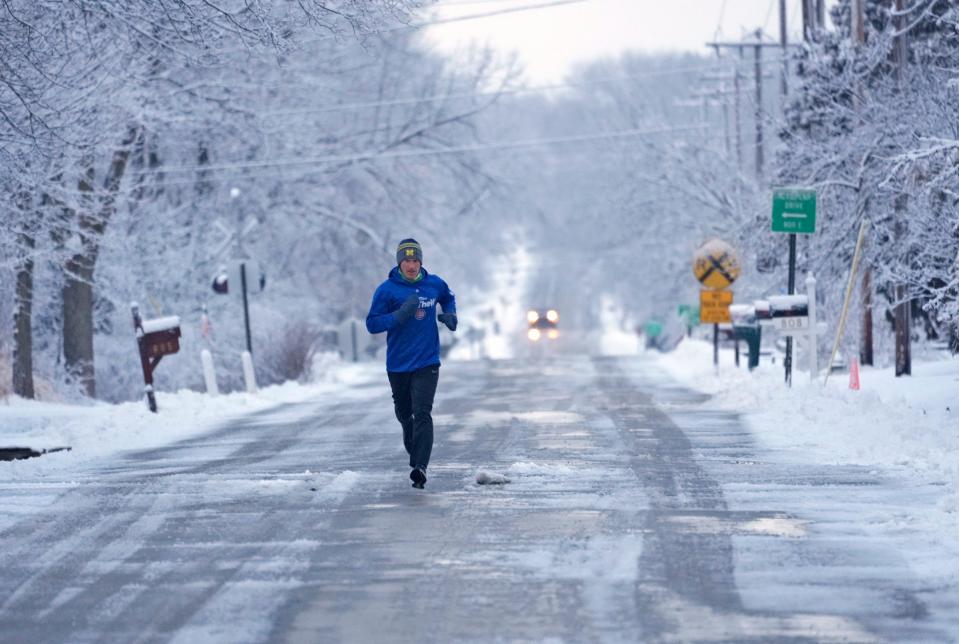Milwaukee received less than half of its typical snowfall during the 2023-24 winter season
This week's forecast might not reflect it, but today is the first official day of spring.
According to the local National Weather Service office, there's an 80% chance of snow Thursday in southern Wisconsin from Madison to Milwaukee. Meteorologists forecast between two and five inches of snow, with the highest chance of snow late in the day Thursday into the night. Snowfall is expected to continue into Friday.
A separate system moving northeast from the southwest into the weekend is likely to bring a rain-snow mix to Milwaukee, local NWS meteorologist Ben Sheppard told the Journal Sentinel.
Snow during the first week of spring is especially ironic this year, as Milwaukee has seen less than half of its normal snowfall during the 2023-2024 winter season.
Here's what to know.

How much did it snow in Milwaukee this winter?
The National Weather Service often measures seasonal snowfall totals over the period between October and April because that virtually always encompasses the months in which Wisconsin sees snow, said local NWS meteorologist Aidan Kuroski.
In this seven-month period, Milwaukee saw an average of 48.7 inches of snow per season between 1991 and 2020, according to NWS data. However, between Oct. 1, 2023, and March 19, 2024, Milwaukee received just 23.9 inches of snow, Kuroski said. That's 24.8 inches fewer, or less than half of the city's normal snowfall.
In previous years over the October to April period, Milwaukee received 52.4 inches of snow in 2022-2023, 28.6 inches in 2021-2022 and 47.8 inches in 2020-2021.
NWS defines winter as December through February. This season, Milwaukee also saw far below normal snowfall during this period. From December 2023 to February 2024, the city received 19.5 inches of snow, almost 18 inches less than the normal total of 37.1 inches.
Here's how this season's monthly snow totals compare to Milwaukee's normal snow totals:
Month | Snowfall in 2023 or 2024 | Normal snowfall (1991-2020) |
October | 3.3 inches | 0.3 inches |
November | 1.1 inches | 2.5 inches |
December | trace amount | 10.4 inches |
January | 16.6 inches | 14.9 inches |
February | 2.9 inches | 11.8 inches |
March | trace amount (through March 19) | 6.7 inches |
This season's below-normal snowfall, however, didn't mean Milwaukee's winter was drier than usual. The winter months actually saw more rainfall than normal. Between December 2023 and February 2024, Milwaukee got 6.33 inches of rain, almost one inch more than the 30-year normal.

Why was there so little snow in Milwaukee this winter?
The primary reason behind Milwaukee's lack of snowfall this winter is a weather phenomenon known as "El Niño," Kuroski said.
An El Niño event is caused when sea surface temperatures in the central and eastern Pacific Ocean warm to above average for several months. During El Niño, the polar jet stream is shifted northward, which limits how far south cold-air intrusions from Canada can travel into Wisconsin.
El Niño brings above-average temperatures to the northern United States, which often result in below-average snowfall in moderate-to-strong El Niño years. Last year, Milwaukee's local NWS office said this winter's El Niño was on track to be one of the strongest ever.
With a three-month average temperature of 34.6 degrees, this winter was Milwaukee's warmest on record by about two degrees.
"The extreme warmth this winter was likely caused by a combination of the El Niño event in the Pacific Ocean and the long-term climatic warming trend," Wisconsin state climatologist Steve Vavrus explained.
Experts say it's hard to tell just yet what extent climate change played in this season's record-breaking warm winter, though it will certainly be studied. According to data from the Wisconsin Initiative on Climate Change Impacts, between 1950 and 2018, the winter daily average temperature has risen as much as six degrees in some parts of Wisconsin.
Journal Sentinel reporter David Clarey contributed to this report.
This article originally appeared on Milwaukee Journal Sentinel: Milwaukee snowfall during winter 2023-2024 was well below average

